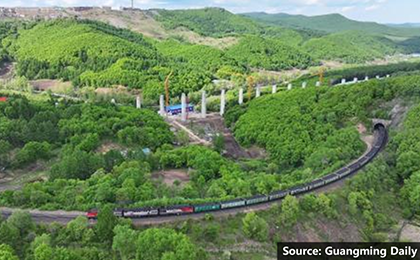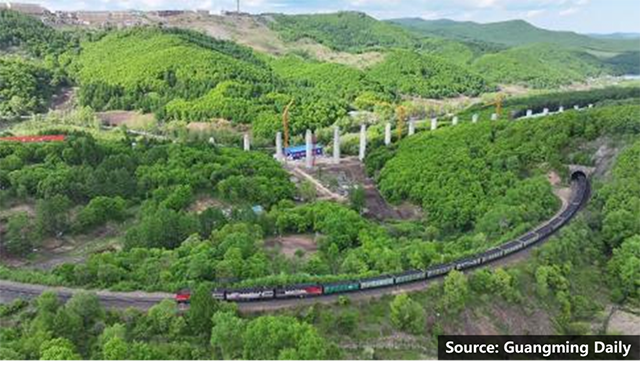



On the morning of May 28, with the final one-meter rock wall broken through by an excavator inside the newly constructed Suifenhe Tunnel-a critical part of the quality improvement and upgrading project of the Binzhou-Suifenhe Railway (Bin-Sui Railway) from Suifenhe to the national border in Heilongjiang Province-this key transportation artery on the China-Europe Railway Express “Eastern Corridor” was officially completed.
The Binzhou-Suifenhe Railway, which connects Harbin City with the Sino-Russian border city of Suifenhe, has a history of over a century. Located at the heart of the Northeast Asia Economic Zone, Suifenhe is the largest railway port in Heilongjiang Province for trade with Russia and serves as a crucial gateway on China’s “Eastern Corridor” for the China-Europe Railway Express.
In recent years, the China Railway Harbin Group Co., Ltd. has leveraged the port’s advantages to improve customs clearance and transportation efficiency. Since the beginning of this year, Suifenhe Station has handled 3.581 million tons of imports and exports, a year-on-year increase of 9%.
To further enhance port transportation capacity, in May 2024, Harbin Railway Group launched a quality improvement project for the Bin-Sui Railway from Suifenhe to the national border. The upgraded route optimizes existing track alignment, increasing train speeds from 55 km/h to 120 km/h and more than doubling the line’s capacity.
The project consists of one tunnel, three bridges, and six roadbed sections. Among them, the Suifenhe Tunnel-measuring 602 meters in length-is the project’s key control structure. Located less than 400 meters in a straight line from the national border, it has been dubbed the "First Tunnel at the Northern Gate of China."
Due to its location in an extremely cold region, the effective construction period is limited to only 6 to 7 months each year. The area includes seasonally frozen soil zones with a maximum frost depth of 2.29 meters, and some sections feature steep mountain slopes, posing significant challenges to construction due to climate and terrain.
“In the design process, we straightened the original S-curve section to improve alignment and enhance line capacity. We also implemented a comprehensive drainage system and adopted special designs for frost heaving prevention and insulation. In addition, we reserved the conditions for future double-tracking. The tunnel’s main structure was completed in May 2025, laying a solid foundation for the full opening of the project within the year,” said Ge Chunmin, Chief Designer of the Bin-Sui Railway Upgrade Project at China Railway Fifth Survey and Design Institute Group.
China Railway Sixth Group, responsible for the construction, applied intelligent, digital, and mechanized construction methods, improving construction efficiency by 12%. The project introduced a smart construction platform utilizing 5G, big data, and artificial intelligence to build a “smart tunnel.” Real-time monitoring modules were deployed to track tunnel excavation cross-sections, ensuring visibility and control for construction safety. The platform also integrated environmental protection instruments for real-time monitoring of energy consumption and emissions, helping reduce dust pollution.
According to reports, the upgrade project of the Bin-Sui Railway from Suifenhe to the national border is expected to be completed within this year. Once operational, it will significantly boost cross-border transportation capacity and enhance the safety and reliability of railway operations.
Source: <https://baijiahao.baidu.com/s?id=1833476971040967253&wfr=spider&for=pc>
Editor & Translator:Li Wei